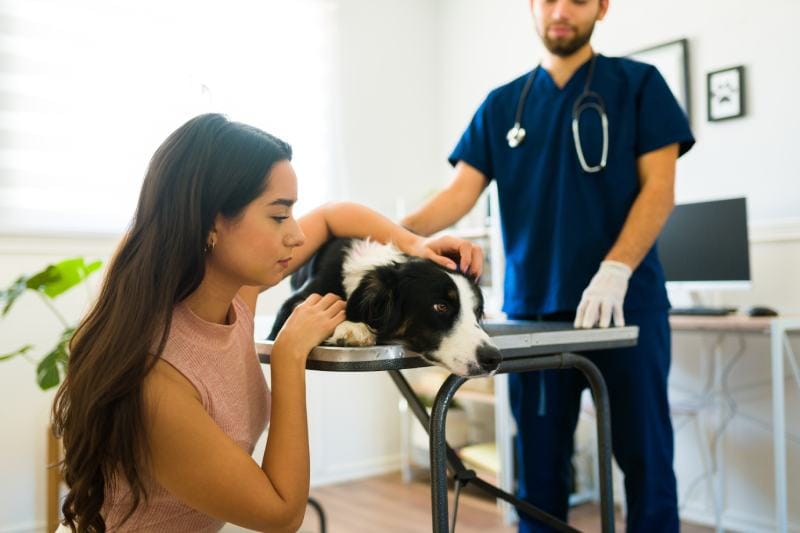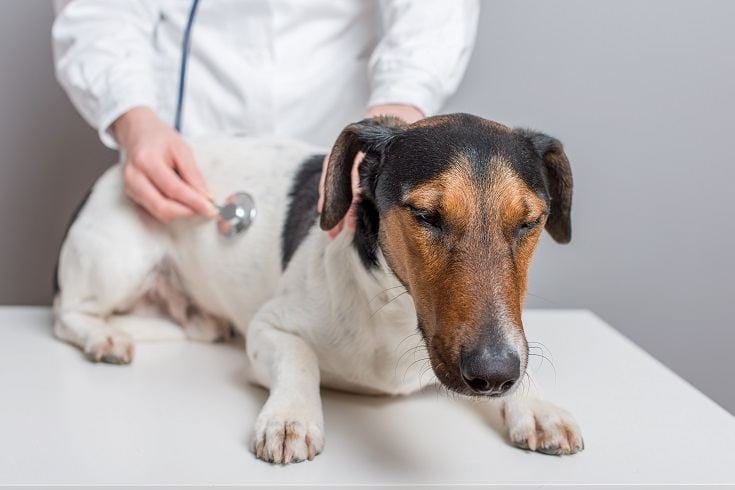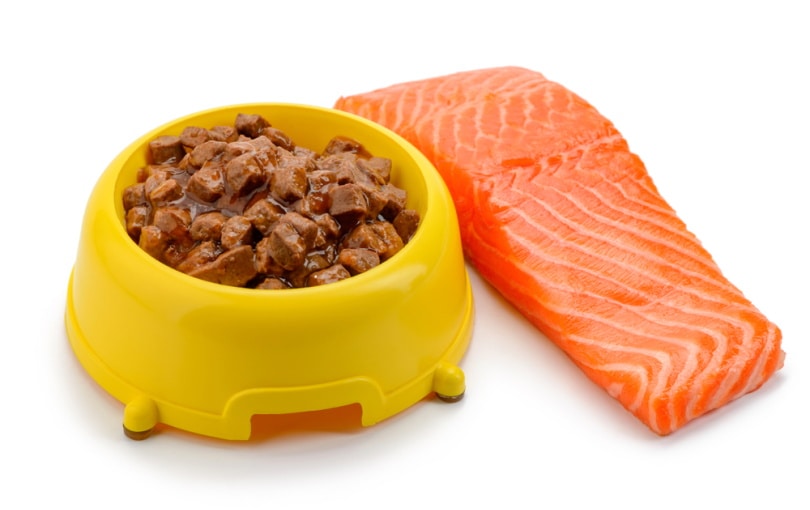Can Dogs Eat Garlic? Is Garlic Safe for Dogs? Vet Approved Facts

Updated on

If you’re an avid chef, then you probably keep garlic in your kitchen. After all, it just makes everything taste better. It’s only natural to want to offer some to your dog — but you really shouldn’t.
Garlic is toxic to dogs, about five times as toxic as onions, in fact. You shouldn’t give your dog anything with garlic in it, and be sure not to leave any stray cloves lying around, just in case.
For more information on why garlic is so bad for dogs and what to do if your dog has accidentally ingested some, read on.
Is Garlic Safe for Dogs?
The reason dogs can’t eat garlic is that it damages their red blood cells.1 This can cause them to rupture (also called hemolysis), which then leaves the dog vulnerable to anemia. Thiosulfinates in Allium species (garlic, onions and leeks) are thought to be responsible for the hemolysis that occurs after ingestion.2 This is often referred to as Heinz body hemolytic anemia.
While garlic is toxic to all dogs, it’s worse for some than others. Japanese breeds like Akitas and Shiba Inus are particularly sensitive. This is possibly related to the high concentration of erythrocyte reduced glutathione and potassium concentrations in the membranes of their red blood cells.3

One thing that makes garlic poisoning especially dangerous is that it can have a delayed onset. Your dog may seem fine for a few days or even a week before collapsing, so it’s important to always take garlic ingestion seriously. Talk to a vet immediately if you know your dog has eaten some. Garlic poisoning and hemolytic anemia can lead to kidney damage that may become life-threatening if left untreated.
Studies have shown that it takes 15 to 30 grams of onion per kilogram of body weight to cause damage to red blood cells in most dogs, and many websites have extrapolated this to garlic. Unfortunately, there is no available evidence-based research or an established dose of garlic that we can say for sure is “safe” vs toxic when it comes to dogs. However, knowing that garlic is five times more toxic to dogs than onions and leeks, even a small amount could lead to toxicosis in some pets.
The average clove of garlic weighs somewhere between 3 and 7 grams, and this will be a significant amount for a small dog that can lead to toxicity. Ingestion of smaller amounts of garlic may also lead to gastroenteritis with vomiting and diarrhea, sometimes accompanied by irritation of the mouth, drooling, nausea, and abdominal pain.
Call your vet or poison control immediately, even if you’ve accidentally given your dog some food with a little garlic in it. Your vet may recommend monitoring for signs of toxicity if they deem the amount is not enough to cause concern, but it’s always better to be safe than sorry. Cooking garlic does not reduce its toxicity.

But I’ve Heard That Garlic Can Keep Fleas and Ticks Away. What Gives?
Many natural pest control advocates believe in giving dogs garlic as a flea and tick repellent, but they do not offer compelling scientific arguments. Using garlic may sound attractive and less expensive if you do not like the idea of rubbing veterinary prescription products onto your dog’s skin.
However, according to a critical evaluation of currently available research and veterinary data, this belief is not backed by science and can certainly be dangerous for your dog. We would strongly recommend not using garlic products on your dog (or cat), as they may lead to signs of toxicity and anemia that can be life-threatening in some cases.
Further extensive research is required into garlic properties and whether garlic can be safely used to control fleas or ticks. Currently, the answer to this question is a strong no.
Speak to your vet about the best veterinary flea and tick products for your dog, as these have been tested rigorously to prove both their safety and efficacy before being distributed on the market.

Are There Any Health Benefits to Feeding My Dog Garlic?
There may be. This is still an area of contention among many vets and researchers. While we know that garlic is toxic in amounts dependent on the dog’s body weight, there hasn’t been much research done on how dogs will respond to it in much smaller doses.
One recent study showed that giving dogs a small amount of aged garlic extract may have produced some health benefits without any major adverse reactions. However, the study population was very small, consisting of only nine dogs, and mild signs of vomiting and diarrhea were present in 4 out of 6 dogs who received the extract. It should be noted, however, that the dogs used in this study were healthy Beagles, so you should be very cautious if you own an Akita or a Shiba Inu.
Some non-veterinary experts recommend garlic supplements for everything from parasite control to heart and kidney disease in people. Garlic does seem to have some anti-carcinogenic, anti-inflammatory, antioxidant, and antiseptic properties, based on studies in humans, but that doesn’t mean it’s applicable or safe for dogs (so does bleach, for example).
If you still do decide to consider a garlic supplement, it (hopefully) goes without saying that you should first and foremost talk to your vet. This also applies when thinking about starting your dog on any supplement, much less one that could potentially be toxic or harmful to your dog.
What Should I Do If My Dog Eats Garlic?
The first thing you should do is determine how much they ate and when, if possible. This is vital information that your vet will need to make informed decisions about your dog’s care.
Then, call your vet or poison control. If they feel that your dog is in danger, they’ll likely advise you to take them to an emergency clinic. There, the vets can monitor your pooch for signs of anemia and safely induce vomiting if necessary.
If your vet tells you not to bother bringing your dog in but to monitor them at home instead, here are the signs you need to worry about:
- Lethargy
- Nausea (often marked by increased drooling)
- Weakness
- Abdominal pain
- Decreased appetite
- Vomiting
- Diarrhea
- Pale gums
- Heavy or rapid breathing and panting
- Red-tinged urine
- Increased drinking
- Increased urination in early stages
- Decreased urination when the kidney disease has progressed
- Collapse
If you notice any of the above, rush your dog to the nearest emergency vet right away. There’s no antidote for garlic toxicity, so it’s critically important to start treatment for anemia and kidney damage as soon as possible.
Anemia is likely to occur within 24 hours and peaks in approximately 72 hours, in the case of a dog ingesting large amounts of garlic. When it comes to smaller amounts, the signs of red blood cell damage may be delayed for 3-7 days.
- Related Read: My Dog Ate Garlic! – Here’s What to Do (Our Vet Answers)

How Do I Prevent My Dog From Eating Garlic?
The best way to ensure that your dog doesn’t eat garlic is to not leave it anywhere that they could get to it. That means not having any cloves lying around on the counter or table.
Also, be careful about feeding human foods to your dog. Certain items — like garlic fries — should be clear no-nos, but garlic is hiding in many other foods as well. Remember that low doses add up over time, so don’t assume that a food is safe simply because there’s not much garlic in it.
Teach everyone in your family (especially children) not to feed the dog garlic. It’s probably easiest if you institute a “no human food” policy rather than expecting everyone to analyze labels.
If you’re growing garlic in your garden, be sure to place a fence or other barrier around it to prevent your dog from munching on it as it grows.
Luckily, most pups don’t care for the taste of raw garlic, so you shouldn’t have much to worry about if your food security isn’t the greatest.
So, What’s the Verdict? Can My Dog Eat Garlic?
Garlic is toxic to dogs, and the amount depends on the dog’s size, so it’s best if you avoid giving your dog any, just to be safe. Additionally, certain breeds (like Akitas and Shiba Inus) are especially susceptible to garlic poisoning. Your dog will just have to make peace with the fact that they’ll never taste your garlic butter shrimp.
However, there’s been pushback in recent years from researchers who claim that garlic can have powerful health benefits in humans if used in small doses. At present, there’s very little evidence to support these claims in dogs, and the risk of making your dog ill by giving them garlic is just too high. It’s best to keep your pooch well away from garlic. Speak to your vet about flea treatment and appropriate diet or supplements, depending on your dog’s health and age, and contact your vet immediately if you think your dog has eaten any garlic at all.
Related Read:
Featured Image Credit: Pixabay












